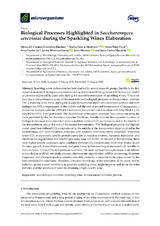Mostrar el registro sencillo del ítem
Biological Processes Highlighted in Saccharomyces cerevisiae during the Sparkling Wines Elaboration
| dc.contributor.author | González-Jiménez, María del Carmen | |
| dc.contributor.author | García-Martínez, Teresa | |
| dc.contributor.author | Puig Pujol, Anna | |
| dc.contributor.author | Capdevila, Fina | |
| dc.contributor.author | Moreno-García, Jaime | |
| dc.contributor.author | Moreno, Juan | |
| dc.contributor.author | Mauricio, Juan C. | |
| dc.date.accessioned | 2020-08-11T12:23:42Z | |
| dc.date.available | 2020-08-11T12:23:42Z | |
| dc.date.issued | 2020 | |
| dc.identifier.uri | http://hdl.handle.net/10396/20404 | |
| dc.description.abstract | Sparkling wines elaboration has been studied by several research groups, but this is the first report on analysis of biological processes according to the Gene Ontology terms (GO terms) and related to proteins expressed by yeast cells during the second fermentation of sparkling wines. This work provides a comprehensive study of the most relevant biological processes in Saccharomyces cerevisiae P29, a sparkling wine strain, during the second fermentation under two conditions (without and with endogenous CO2 overpressure) in the middle and the end of second fermentation. Consequently, a proteomic analysis with the OFFGEL fractionator and protein identification with LTQ Orbitrap XL coupled to HPLC were performed. The classification of biological processes was carried out using the tools provided by the Saccharomyces Genome Database. Results indicate that a greater number of biological processes were identified under condition without CO2 overpressure and in the middle of the fermentation versus the end of the second fermentation. The biological processes highlighted under condition without CO2 overpressure in the middle of the fermentation were involved in the carbohydrate and lipid metabolic processes and catabolic and biosynthetic processes. However, under CO2 overpressure, specific protein expression in response to stress, transport, translation, and chromosome organization and specific processes were not found. At the end of fermentation, there were higher specific processes under condition without CO2 overpressure; most were related to cell division, growth, biosynthetic process, and gene transcription resulting in increased cell viability in this condition. Under CO2 overpressure condition, the most representative processes were related to translation as tRNA metabolic process, chromosome organization, mRNA processing, ribosome biogenesis, and ribonucleoprotein complex assembly, probably in response to the stress caused by the hard fermentation conditions. Therefore, a broader knowledge of the adaptation of the yeast, and its behavior under typical conditions to produce sparkling wine, might improve and favor the wine industry and the selection of yeast for obtaining a high-quality wine. | es_ES |
| dc.format.mimetype | application/pdf | es_ES |
| dc.language.iso | eng | es_ES |
| dc.publisher | MDPI | es_ES |
| dc.rights | https://creativecommons.org/licenses/by/4.0/ | es_ES |
| dc.source | Microorganisms 8(8), 1216 (2020) | es_ES |
| dc.subject | Saccharomyces cerevisiae | es_ES |
| dc.subject | Sparkling wine | es_ES |
| dc.subject | Fermentation | es_ES |
| dc.subject | GO terms | es_ES |
| dc.subject | Protein | es_ES |
| dc.title | Biological Processes Highlighted in Saccharomyces cerevisiae during the Sparkling Wines Elaboration | es_ES |
| dc.type | info:eu-repo/semantics/article | es_ES |
| dc.relation.publisherversion | http://dx.doi.org/10.3390/microorganisms8081216 | es_ES |
| dc.relation.projectID | Gobierno de España. RTA2014-00016-C03-03 | es_ES |
| dc.rights.accessRights | info:eu-repo/semantics/openAccess | es_ES |

